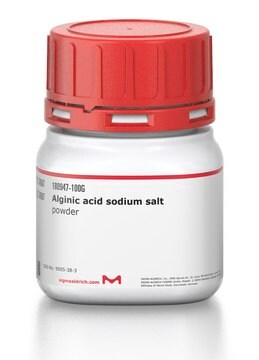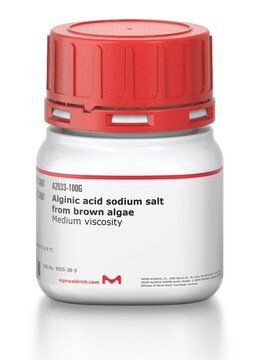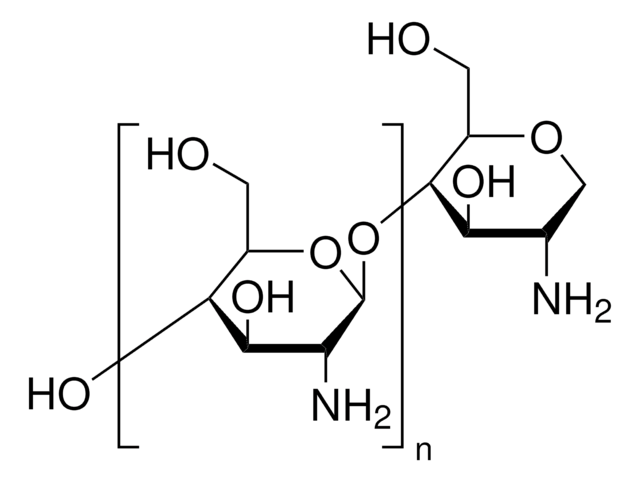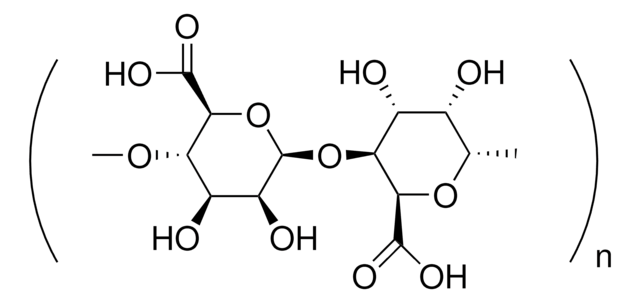A1603
Alginate Lyase
powder, ≥10,000 units/g solid
Sinónimos:
poly-beta-D-mannuronate lyase
Iniciar sesiónpara Ver la Fijación de precios por contrato y de la organización
About This Item
Número de CAS:
MDL number:
UNSPSC Code:
12352204
NACRES:
NA.54
Productos recomendados
General description
Alginate lyases is present in several marine algae, marine mollusks and a vast range of marine and terrestrial bacteria.
Application
Alginate Lyase has been used:
- in the pre-processing of enzyme
- to de-encapsulate cells
- to digest Pseudomonas exopolysaccharide to facilitate electroporation
Alginate Lyase is used to break down alginate or alginic acid and to reduce viscosity. It is useful during follicle isolation, encapsulation, and culture .
Biochem/physiol Actions
Alginate lyases actively participates in the saccharification of the acidic polysaccharides for the production of bioethanol.
Breaks down alginate or alginic acid to smaller molecules and reduces viscosity.
Unit Definition
One unit will produce an increase the A235nm of 1.0 per minute per mL of sodium alginate solution at pH 6.3 at 37 °C
Preparation Note
Add 0.15 mI of enzyme solution (1 un/ml) to 4.5 ml of 0.1% sodium alginate (pH 6.3). Incubate at 37 °C for 30 minutes. Terminate reaction by addition of 4.65 ml of 0.1 N NaOH.
Other Notes
View more information on enzymes for complex carbohydrate analysis at www.sigma-aldrich.com/enzymeexplorer
signalword
Danger
hcodes
pcodes
Hazard Classifications
Resp. Sens. 1
Storage Class
11 - Combustible Solids
wgk_germany
WGK 1
flash_point_f
Not applicable
flash_point_c
Not applicable
ppe
Eyeshields, Gloves, type N95 (US)
Certificados de análisis (COA)
Busque Certificados de análisis (COA) introduciendo el número de lote del producto. Los números de lote se encuentran en la etiqueta del producto después de las palabras «Lot» o «Batch»
¿Ya tiene este producto?
Encuentre la documentación para los productos que ha comprado recientemente en la Biblioteca de documentos.
Los clientes también vieron
W Hashimoto et al.
Journal of bacteriology, 182(16), 4572-4577 (2000-07-27)
A bacterium, Sphingomonas sp. strain A1, can incorporate alginate into cells through a novel ABC (ATP-binding cassette) transporter system specific to the macromolecule. The transported alginate is depolymerized to di- and trisaccharides by three kinds of cytoplasmic alginate lyases (A1-I
Shinji Sakai et al.
Biomaterials, 33(28), 6721-6727 (2012-07-10)
We report a method for wrapping tissues with a pre-established cage-like layer composed of living cells. We encapsulated multicellular aggregates of human hepatoma HepG2 cells as a model of tissues such as pancreatic islets and hepatocyte spheroids in alginate-based hydrogel
Elizabeth M Parrish et al.
Reproduction (Cambridge, England), 142(2), 309-318 (2011-05-26)
Ovarian follicle maturation results from a complex interplay of endocrine, paracrine, and direct cell-cell interactions. This study compared the dynamic expression of key developmental genes during folliculogenesis in vivo and during in vitro culture in a 3D alginate hydrogel system.
Bacteriophages phi MR299-2 and phi NH-4 Can Eliminate Pseudomonas aeruginosa in the Murine Lung and on Cystic Fibrosis Lung Airway Cells
Alemayehu D, et al.
mBio, 3(2) (2012)
François Thomas et al.
Environmental microbiology, 14(9), 2379-2394 (2012-04-20)
Alginate constitutes a significant part of seaweed biomass and thus a crucial nutrient for numerous marine heterotrophic bacteria. However, the mechanisms for alginate assimilation remain largely unknown in marine microorganisms. We show here that the genome of the marine flavobacterium
Nuestro equipo de científicos tiene experiencia en todas las áreas de investigación: Ciencias de la vida, Ciencia de los materiales, Síntesis química, Cromatografía, Analítica y muchas otras.
Póngase en contacto con el Servicio técnico








